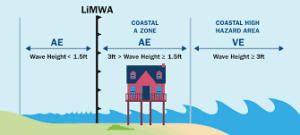A “non-flood zone” typically refers to an area that is not classified as a Special Flood Hazard Area (SFHA) by FEMA. These include:
-
Zone X (unshaded): Minimal risk
-
Zone B or C: Moderate risk
-
Zone X (shaded): Still low, but higher than minimal risk
Homes in these areas are not required by law to carry flood insurance if they have a federally backed mortgage. However, “low risk” does not mean no risk.
Why Flood Insurance Matters in Non-Flood Zones
1. Flooding Can Happen Anywhere
Flooding is the most common and costly natural disaster in the U.S. A heavy rainstorm, clogged drains, snowmelt, or nearby construction can cause flash flooding in areas that have never flooded before.
2. Climate Change and Urbanization
Increased rainfall intensity and urban sprawl contribute to flooding in previously “safe” zones. Concrete and poor drainage reduce the land’s ability to absorb water.
3. Homeowners Insurance Doesn’t Cover Flood Damage
A standard homeowners policy typically does not cover flood-related damage. That means if your basement fills with water or a flash flood hits your neighborhood, you’ll pay out of pocket unless you have separate flood insurance.
What Does Flood Insurance Cover?
Flood insurance—whether bought through the National Flood Insurance Program (NFIP) or a private insurer—covers direct physical losses caused by flooding.
Building Property Coverage (up to $250,000 under NFIP):
-
Foundation, walls, and staircases
-
Electrical and plumbing systems
-
Central air conditioning, water heaters, and furnaces
-
Built-in appliances and cabinetry
-
Detached garages (limited)
Personal Property Coverage (up to $100,000 under NFIP):
-
Furniture, electronics, and clothing
-
Curtains and portable appliances
-
Freezers and their contents
-
Certain valuables (limited)
Note: Coverage does not include landscaping, currency, vehicles, or basement improvements like carpeting or wall panels.

Cost of Flood Insurance in Non-Flood Zones
Good news: flood insurance is significantly cheaper in non-flood zones than in high-risk areas.
Average Cost (2025 estimates):
-
NFIP policy in low-risk zone: $300–$600 per year
-
Private policy: $250–$700/year (depending on provider and limits)
Premiums depend on:
-
Your property’s elevation
-
Distance from water sources
-
Building materials and structure
-
Deductibles and coverage amounts
Since risk is lower in these zones, you may qualify for a Preferred Risk Policy (PRP) through the NFIP, which offers discounted rates.
Where to Buy Flood Insurance
You can buy flood insurance from two main sources:
1. National Flood Insurance Program (NFIP)
-
Backed by FEMA and the U.S. government
-
Up to $250,000 for buildings, $100,000 for contents
-
30-day waiting period before coverage begins (except for loan closings)
2. Private Flood Insurance Providers
-
Higher coverage limits (often up to $1 million+)
-
May offer shorter waiting periods
-
Often include additional coverages (e.g., temporary housing, basement improvements)
Top private flood insurers in 2025 include:
-
Neptune Flood
-
TypTap Insurance
-
Aon Edge
-
Chubb
-
Zurich
Some homeowners combine NFIP and private policies for broader protection.
Real-Life Scenarios: Why Non-Flood Zone Insurance Pays Off
Scenario 1: Flash Flood in a Suburban Neighborhood
A suburban neighborhood in Zone X gets hit by a freak thunderstorm that dumps 10 inches of rain in 2 hours. Storm drains back up, water flows into garages and basements. Homes without flood insurance pay $10,000–$30,000 in repairs. Those with coverage pay only their deductible.
Scenario 2: New Development Alters Drainage
You live on a hill—but new housing developments below you change water flow patterns. During a storm, runoff pools against your foundation and seeps into the basement. Since you’re in a “low-risk” zone, you didn’t think to buy flood insurance—until now.
How to Assess Your Flood Risk in a Non-Flood Zone
Use these tools and methods to evaluate whether flood insurance is right for you:
1. FEMA Flood Maps
Visit FEMA Flood Map Service Center to check your property’s flood zone.
2. Risk Rating 2.0 (NFIP Update)
Since 2021, FEMA’s Risk Rating 2.0 gives more accurate and personalized flood risk assessments based on:
-
Rainfall
-
Elevation
-
Distance to water
-
Foundation type
3. FloodFactor.com
Enter your address to see detailed flood risk projections (powered by First Street Foundation).
Is Flood Insurance Worth It in a Non-Flood Zone?
Here’s a quick comparison:
| Scenario | With Insurance | Without Insurance |
|---|---|---|
| $20,000 flood damage | Pay $1,000 deductible | Pay $20,000 out of pocket |
| Annual premium (low-risk) | ~$500 | $0 upfront |
| Emotional peace of mind | ✅ | ❌ |
Considering that one inch of water can cause up to $25,000 in damage, the math is simple—yes, it’s often worth it.
Tips to Lower Your Premium Even Further
-
Choose a higher deductible – Up to $10,000 (if you can afford it)
-
Flood-proof your home – Install flood vents, elevate appliances
-
Bundle with homeowners policy – Some insurers offer multi-policy discounts
-
Buy before the storm – Policies usually have a waiting period (30 days for NFIP)

Frequently Asked Questions
Q: Can renters in non-flood zones get flood insurance?
A: Yes. Renters can get coverage for personal belongings even if the property itself isn’t insured.
Q: Do mortgage lenders require flood insurance in low-risk zones?
A: Not usually—but they may suggest it.
Q: Does FEMA help after a flood in non-zones?
A: FEMA assistance is limited, often capped at a few thousand dollars. It’s not a substitute for insurance.
Conclusion
Floods don’t only happen in coastal towns or riverside communities. In fact, they often strike where people least expect them—in non-flood zones. And while your risk may be lower, it’s far from zero. Given the relatively low premiums and high potential losses, flood insurance is a wise investment, even if you’ve never seen water in your street.Don’t wait until after the storm. Be proactive, protect your home, and consider purchasing a flood policy today—because peace of mind is priceless, and water damage isn’t.






